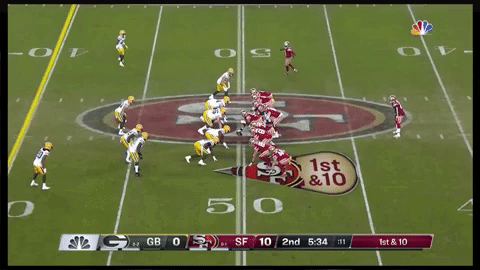San Francisco 49ers fans can rejoice. Their favorite team reached a contract extension with perhaps their most valuable offensive player, tight end George Kittle. The parties came to agreement on a five-year contract extension worth $75 million, with roughly half of that coming in the form of guaranteed money. Ian Rapoport and Mike Silver were among the first with the details:
The #49ers & star TE George Kittle are in agreement on a 5-year, $75M extension, sources tell me & @MikeSilver, one that gives him more than half of it in guarantees. Language is being worked on, but numbers are there. One of their top players, this was a big-time priority 💰💰💰
— Ian Rapoport (@RapSheet) August 13, 2020
This is a big-time contract for a tight end, and the deal once executed would make Kittle the highest-paid tight end in the NFL.
So the question immediately becomes: Is Kittle worth those numbers?
In a word, yes.
The 49ers tight end has been dominant the past two seasons, eclipsing 1,000 receiving yards in both years and averaging 15.6 yards per reception in 2018, and 12.1 yards per reception in 2019. Kittle is also impressive after the catch, as he averaged 9.9 yards after the catch in 2018, and another 7.3 YAC/reception last season.
Beyond the statistics, what makes Kittle so effective in San Francisco – and therefore worth this contract – is how he serves as a core component of what the 49ers do offensively. He should be viewed in a similar way that people feel about Julio Jones in Atlanta or Michael Thomas in New Orleans. In essence, the offense runs through him in large part.
Take this completion from Jimmy Garoppolo to Kittle from Week 17 against the Seattle Seahawks:

Kittle begins this play in a wing alignment to the left, before motioning across the formation to a boundary alignment on the right. As the tight end tracks across the formation, Garoppolo notices the minor adjustment from the defense, simply sliding the cornerback out over Kittle. This is a clue to the QB that the Seahawks are in zone converage.
Then, Kittle runs the outside dig in a pair of dig routes, and this gets him into space against the zone coverage. Garopplo hits him between the underneath defenders for the big gain.
Armed with the information available to him before the snap, the QB makes the right decision with the ball. But with Kittle running this route from a traditional WR spot, it puts him in position to be successful on the play.
Here’s Kittle running an over route against the Los Angeles Rams, with Garoppolo working off of play-action:

With the play-action elements in place, Kittle is the primary read here for the quarterback. The hope is that the combination of jet motion and inside run will suck the linebackers downhill, creating space for Kittle working over the middle. This is exactly what happens.
Seth Galina, who does tremendous work covering college football and schemes for Pro Football Focus, wrote recently about the over route and its prevalence in the NFL. His cover boy for the piece? Kittle. Included in the article are clips like this:

Again, Garoppolo is looking to Kittle as soon as he comes out of the play-action fake on this design. The offense seemingly running through the tight end himself.
Something else Galina found, which points to Kittle’s value in the 49ers offense, is this statistic:
The offenses from the old Mike Shanahan tree try to free their crossing route with a corner route instead of a post, and they’ll use it off play action. Overall, 54% of all deep crossers were thrown after play action in 2019 — and 55% of them were thrown off play action over the last six seasons — but that number is 81% with the San Francisco 49ers, 71% with the Los Angeles Rams, 62% with the Tennessee Titans and 83% with the Minnesota Vikings. All those teams run a very similar offensive system.
The 49ers are a heavy play-action team, as we all know, and using Kittle on these deep crossers is a big component of their game plan.
Perhaps the threat of Kittle and the over route – on a play-action design of course – led to this completion against the Atlanta Falcons:

Kittle aligns as the apex receiver in a three-receiver bunch, and fakes a crossing route before breaking to the outside on a deep route, part of a Sail concept. Again, this is the primary read for the quarterback on such a design, that deep out route that makes up the middle component of a three-level read. Kittle’s footwork and full-body route running gets him open, and he high points the football for a big gain.
But what he does as a receiver is just a component of what Kittle brings to the table. It is a big component of course, but the tight end is also effective when tasked with the blocking parts of playing the position.
On this play from the Divisional Round, Kittle works to the second level to throw a critical block on the middle linebacker:

Take this touchdown run against the Rams from Week 16. The 49ers run outside zone to the right, and Kittle is the player they are running behind:

Kittle throws a big block at the aiming point, leading to the touchdown run.
Simply put, George Kittle is a tight end that the 49ers’ passing game can run through, and their running game can run behind. That is worth a big-time extension.
